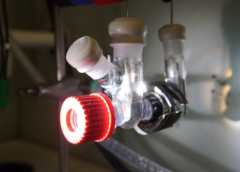A new recycling method uses sunlight to simultaneously convert carbon dioxide and plastic waste into sustainable biofuels and useful chemical products.
In order to create a circular economy—one where man-made materials are fully recycled and reused—humanity needs to reach net zero emissions for carbon dioxide and net zero waste for plastic usage. Is it possible to achieve both at once? A new study from the University of Cambridge demonstrates a technological innovation that uses solar energy to simultaneously transform carbon dioxide and plastic into value-added products.
Value can be extracted from carbon dioxide emissions and plastic waste
In 2021, global carbon dioxide emissions increased by over two billion tonnes (that’s over four trillion pounds!), the highest increase in history in absolute terms (by IEA analysis). The other primary pollutant on our planet, plastic waste, makes up 80 percent of all ocean pollution. Studies predict that there will be more plastics than fish in the sea by 2050. Plastic can take several hundred years to decompose in nature, and even then, plastic materials remain in the form of diminutive particles known as microplastics.
Instead of using plastic objects once and then throwing them away in oceans and landfills, the circular-economy model suggests recycling plastic so that it continues to be a valuable material. Based on these principles, scientists have spent years studying how to capture human-produced carbon dioxide, which remains in the atmosphere for several generations, and then recycle it into useful chemicals and fuels.
In a first for scientists studying recycling, Dr. Erwin Reisner from the Yusuf Hamied Department of Chemistry at the University of Cambridge and his group of researchers detailed how to couple carbon dioxide and plastic waste recycling using renewable solar energy. Their recycling method relies on an innovative solar reactor that accumulates carbon dioxide and plastic waste into two separate compartments, transforming both into new chemical products. This chemical transformation starts when the system’s photovoltaic cell absorbs solar energy. Next, added catalysts make the chemical reaction more efficient without the need to increase the temperature or the pressure conditions. If a different type of catalyst is used, it is possible to change the final chemical product. Altogether, the new solar reactor promises a more sustainable, efficient, and selective process for recycling carbon dioxide and plastic waste.
Mastering carbon dioxide recycling
In nature, green plants use photosynthesis to capture sunlight and transform it into chemical energy that is stored as carbohydrates, most commonly glucose. Plant leaves can perform photosynthesis efficiently because they are equipped with special catalysts. Sunlight activates these catalysts when it hits the leaf surface. As a result, water and atmospheric carbon dioxide turn into oxygen and carbohydrates.
The idea of artificially mimicking photosynthesis has intrigued scientists for years and gave rise to various man-made systems that reproduce photosynthesis. Usually, these systems are made of a photovoltaic component, which absorbs sunlight, and an electrochemical component that converts carbon dioxide into a biofuel with the aid of a catalyst. Generally, this process is known as photoelectrochemical carbon dioxide conversion (PEC). Unfortunately, it is challenging to upscale these systems to produce massive amounts of biofuel because the PEC conversion rate is low.
Recently, the team from the University of Cambridge made a promising step in upscaling PEC. Their solar reactor increased the efficiency of carbon dioxide conversion (in some cases making the process up to 100 times more efficient) and brought versatility to the synthesis of end-products. This was done using sunlight as the only source of energy and, unlike other similar methods of conversion, does not require any external voltage.
To achieve these impressive results, the light absorber of the reactor is made of perovskite, a more efficient and practical material than the silicon traditionally used in the manufacture of solar cells. The integration of three different catalysts allows for the production of three valuable products from carbon dioxide: syngas that can be used as a fuel source or as an intermediate for the production of other chemicals, formate (an important ingredient for biological fuels), and carbon monoxide. A fourth catalyst was used to convert plastic bottles into glycolic acid, a chemical used in the cosmetics industry.
RELATED: Blue and Red Light: Exploring the Potential
Adapting for the future
The team from the University of Cambridge argues that its invention is a demonstration of how green solar energy can be harnessed to provide sustainable biofuels in combination with effective plastic waste recycling. But, more importantly, the authors stress the precise and adaptable nature of their solar design, which they think can produce different and more complex added-value products depending on which catalyst is used.
Of course, the ultimate goal is to see this method of artificial photosynthesis and plastic recycling upscaled to sustainable commercial implementation. The authors conclude that their innovative solar reactor is a key step in this direction.
This study was published in the journal Nature Synthesis.
Reference
Bhattacharjee, S., Rahaman, M., Andrei, V., Miller, M., Rodríguez-Jiménez, S., Lam, E., Pornrungroj, C., & Reisner, E. (2023). Photoelectrochemical CO2-to-fuel conversion with simultaneous plastic reforming. Nature Synthesis, 2, 182–192.


About the Author
Rachil Koumproglou is a Plant Scientist with a genuine passion for sustainable solutions. She holds a MSc in Science Communication and is an enthusiast reader of classical literature. Find her on LinkedIn: https://www.linkedin.com/in/rachil-koumproglou-a3926a96/.

